PREVIOUS
Iron Age in Tamil Nadu - Part 02
February 5 , 2025
33 days
665
0
Iron Age in Tamil Nadu - Part 02
(இதன் தமிழ் வடிவத்திற்கு இங்கே சொடுக்கவும்)
Antiquity of Iron in Tamil Nadu
Recent Dating and Research
- Iron Age graves at Mangadu, Kilnamandi, Mayiladumparai, Adichanallur, and Sivagalai have led to a revision of previously held views on the introduction of iron.
- Sources: Research by Sivanantham (2022), Rajan (2022, 2017), and Gnanaraj (2023) provides new insights into the Iron Age in Tamil Nadu.
Iron Age Sites in South India
- Iron Age Sites in South India: South India is known for its significant Iron Age sites, with Tamil Nadu being no exception.
- Number of Iron Age Graves: Over 3,000 Iron Age graves have been identified, including 1362 urn burials, 996 cairn circles, 225 stone circles, and 634 habitation-cum-burial sites.
Excavations and Discoveries
- Limited Excavations: Only a few of these sites have been excavated, and many of these excavations were brief, yielding limited data.
- Recent Target-Oriented Excavations: More focused excavations have been initiated in recent years by the Tamil Nadu State Department of Archaeology, the Archaeological Survey of India, and various universities.
Early Iron-Yielding Sites
- Overview of Early Iron Sites: A brief overview of early Iron Age sites in Tamil Nadu provides insight into the nature of the region’s Iron Age.
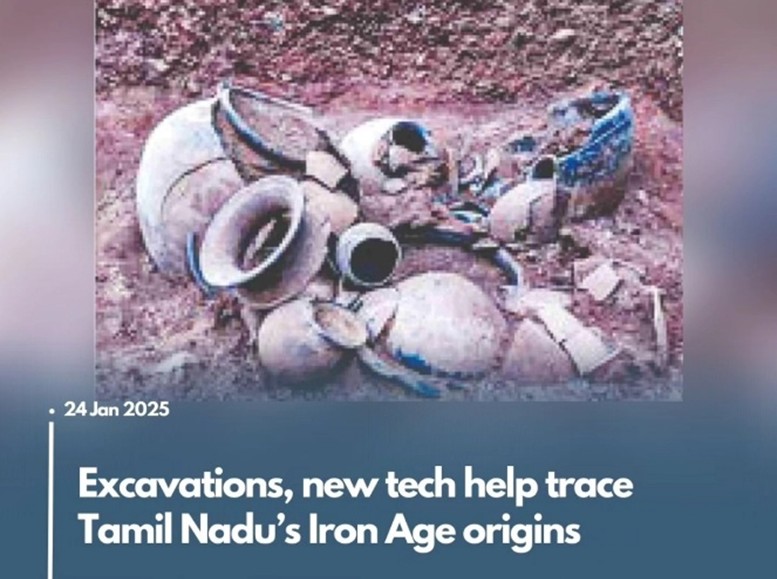
Mangadu
Iron Sword Discovery
- Location: The iron sword was found in a disturbed cist burial at Mangadu, located in Mettur taluk, Salem district.
- Sample and Dating: The sample collected from the sword provided a conventional age of 1263 BCE.
- This date was obtained from the NSF-Arizona AMS Facility.
Calibrated Date
- Mean Calibrated Value: The mean calibrated value was placed at approximately 1510 BCE.
Significance of the Date
- Early Iron Introduction: This discovery provided one of the earliest dates for iron in Tamil Nadu, sparking greater interest in the study of iron technology.
- Ongoing Research: Following this discovery, the search for the introduction of iron in Tamil Nadu continued, marking a significant milestone in archaeological studies of the region.
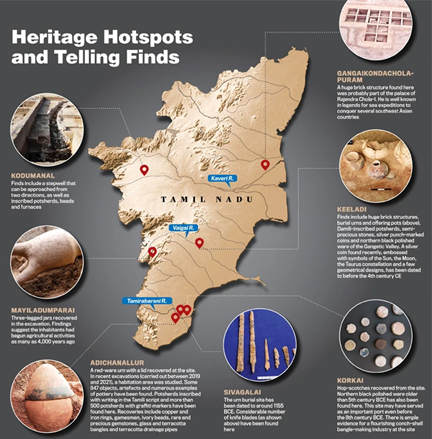
Kilnamandi
Excavation Overview
- Location: Excavations were conducted in July-August 2023 at Kilnamandi, located in Vandavasi taluk, Tiruvannamalai district, Tamil Nadu.
- Burial Types: The excavations uncovered a sarcophagus placed both in a pit and in a cist.
Iron Objects and Dating
- Iron Objects Found: A sample collected from a stone circle that entombed a pit burial with sarcophagus, along with iron objects, was dated.
- Mean Calibrated Value: The mean calibrated value for this sample was approximately 1692 BCE.
Significance of the Findings
- Earlier Iron Date: This finding pushed the date of iron usage in Tamil Nadu a century earlier than the date from Mangadu.
- First Sarcophagus Burial Date: This AMS 14C date (1692 BCE) marked the first time a sarcophagus burial was dated in Tamil Nadu, adding a new layer of understanding to the region’s burial practices.
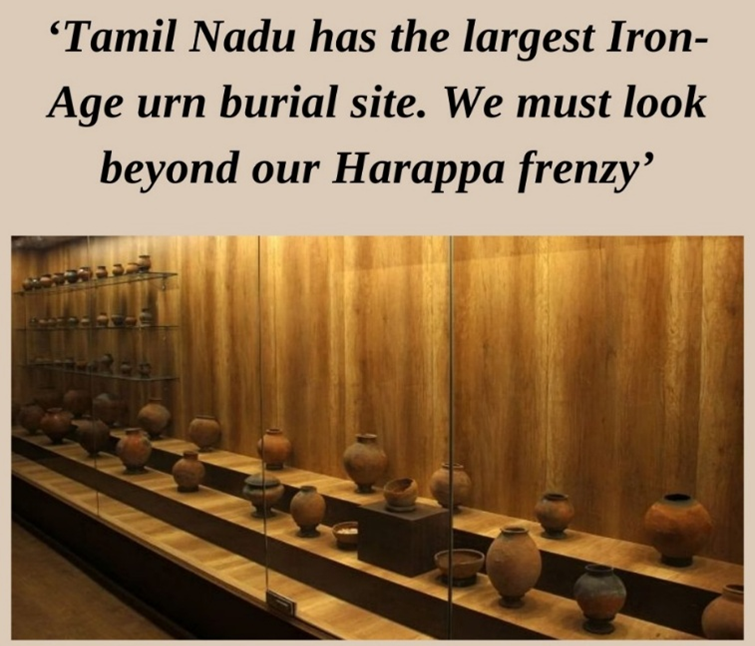
Adichanallur
Location and Overview
- Site Location: Adichanallur is situated on the right bank of the river Thamirabarani, about 4 km west of Srivaikuntam, 24 km southeast of Tirunelveli, and 9 km west of Korkai, the ancient port city and capital of the Sangam Age Pandyas.
- Site Area: The graveyard, referred to as parambu (dry elevated mound), encompasses an area of 125.04 acres on both sides of the Tirunelveli–Tiruchendur highway.
Excavation History
- Initial Discovery: Discovered by F. Jagor of Berlin in 1876, the site was later excavated by Alexander Rea in 1902-04, becoming an iconic archaeological site.
- Re-excavations: T. Sathyamurthy of ASI re-excavated the site in 2004-2005.
- Further excavations were initiated by Arun Raj of ASI in 2021-22 and by the Tamil Nadu State Department of Archaeology in 2021-23.
Findings from Excavations
- Pottery: The excavations uncovered a variety of finely made pottery, including black-and-red ware, red ware, black polished ware, and white painted black-and-red ware.
- Metal Objects: The graves revealed a variety of metal objects, such as swords, knives, spears, arrowheads, tridents, and bronze ornaments (bangles, rings, and decorated stands).
- Bronze and Iron Objects: Unique bronze objects, including animals, birds, a mother goddess, and gold items like rings and diadems, were found at the site.
- Iron objects such as hoe-spades, triple-forked spears, and a mother goddess were also present.
- Skeletal Remains: Most skeletal remains were found in a secondary context, with many associated artifacts like ceramics, bronze objects, and iron tools.
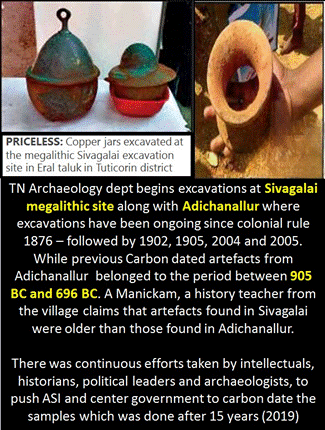
Iron Age Habitation Mound
- Location of Habitation Mound: The Iron Age habitation mound, covering around 50 acres, was identified at two localities using remote sensing and GIS.
- One is located within the present Vellur-Adichanallur tank, while the other is in Adichanallur village.
- Additionally, iron implements and hopscotches were found, especially in the seventh layer.
- Floor Levels: Three phases of floor levels were noted in the top three layers of the mound.
AMS 14C Dating and Iron Introduction
- Charcoal Sample: A charcoal sample collected from layer 4 at a depth of 220 cm in the habitation mound yielded a conventional date of 2060 BCE.
- Calibrated Date: The calibrated date of the sample ranged from 2517 BCE to 2613 BCE, with a mean value of 2517 BCE (93.9%).
- Significance of Date: This date pushed the introduction of iron in Tamil Nadu to the mid-3rd millennium BCE, marking a significant early period for the use of iron in the region.
Sivagalai (Iron Age Urn Burial Site)
Location and Overview: Sivagalai-parambu
- Area: The graveyard covers an area of approximately 500 acres.
- Site Location: Sivagalai is situated 7 km north of the river Porunai (Thamirabarani), about 31 km southwest of Thoothukudi town, and 10 km northeast of Srivaikuntam in Eral taluk, Thoothukudi district, Tamil Nadu.
- The site is located northwestern of the village Sivagalai, with the graveyard extending into the neighbouring villages of Betmanagaram and Moolakarai.
- Nearby Sites: Notable nearby sites include the microlithic site Sayarpuram (about 15 km to the north), the famous urn burial site Adichanallur (about 15 km to the west), and the Early Historic Pandya port Korkai (about 15 km to the east).
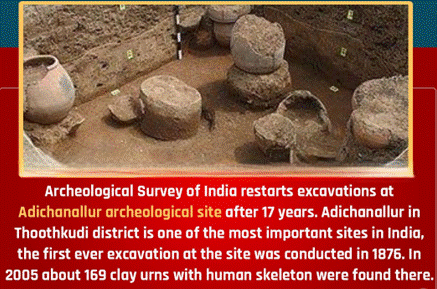
Excavation History
- Excavations Conducted by Tamil Nadu State Department of Archaeology: Excavations were undertaken in the years 2019-2020, 2020-21, and 2021-22 to explore the archaeological significance of Sivagalai.
- Excavation Areas: Excavations took place across eight localities.
- Burial Localities: Three burial sites were excavated at Sivagalai, Betmanagaram, and Srimoolakarai.
- Habitation Localities: Five habitation mounds were excavated at Valappalanpillai-thiradu, Parakiramapandi-thiradu, Chekkadi-thiradu, Aavarangadu, and Pottalkottai-thiradu.
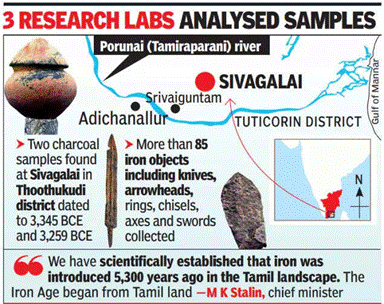
Excavation Details
- Excavation Scope: Excavations were carried out across various localities.
- Sivagalai: 17 trenches (10x10 m) and 39 quadrants were excavated.
- Betmanagaram: 3 trenches with 8 quadrants.
- Srimoolakarai: 4 trenches with 16 quadrants.
- Total Excavated Area: 24 trenches and 63 quadrants.
- Number of Urns Exposed: 160 urns in total.
Urn Types:
- Red Ware Urns: Majority of the urns (151) were made from red ware and are chronologically earlier than black-and-red ware urns.
- Black-and-Red Ware Urns: Only 9 urns were made from black-and-red ware.
Characteristics of Urns
- Pit Depth: The depth of the pits for the urns ranged up to 150 cm, with diameters of 100-110 cm.
Urn Dimensions:
- Maximum height: 115 cm
- Maximum breadth: 65 cm
- Thickness: 4.5 cm
- Urn Preservation: Some urns showed cracks due to pressure from overlying soil, while others had intact lids that prevented soil from percolating inside.
Excavated Grave Goods:
- Predominantly ceramics such as bowls, lids, ring stands, and pots (nearly 750 items).
- Iron objects were found inside and outside the urns, including knives, arrowheads, rings, chisels, axes, and swords.
Notable Findings
- Interesting Urns: The third urn in this trench was intact with a lid, and no soil had percolated inside.
- Inside the urn, skeletal remains, iron objects, and paddy grains were found.
- Paddy Sample: The paddy sample collected from Urn-3 was AMS14C dated to 1155 BCE.
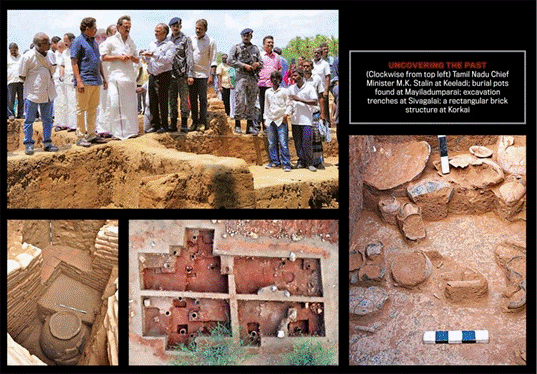
Other AMS14C Dates:
- A sample from the habitation site with Tamiḻi (Tamiḻ-Brāhmī) inscribed potsherds yielded a date of 685 BCE.
- Three other dates from urn burials with iron objects dated back to between 2953 BCE and 3345 BCE, indicating the introduction of iron in Tamil Nadu during the first quarter of the 4th millennium BCE.
- The findings from Sivagalai contribute significantly to our understanding of the early use of iron in Tamil Nadu, showing evidence for iron introduction as early as the 4th millennium BCE and providing a direct chronological framework for the Iron Age in the region.
Leave a Reply
Your Comment is awaiting moderation.


